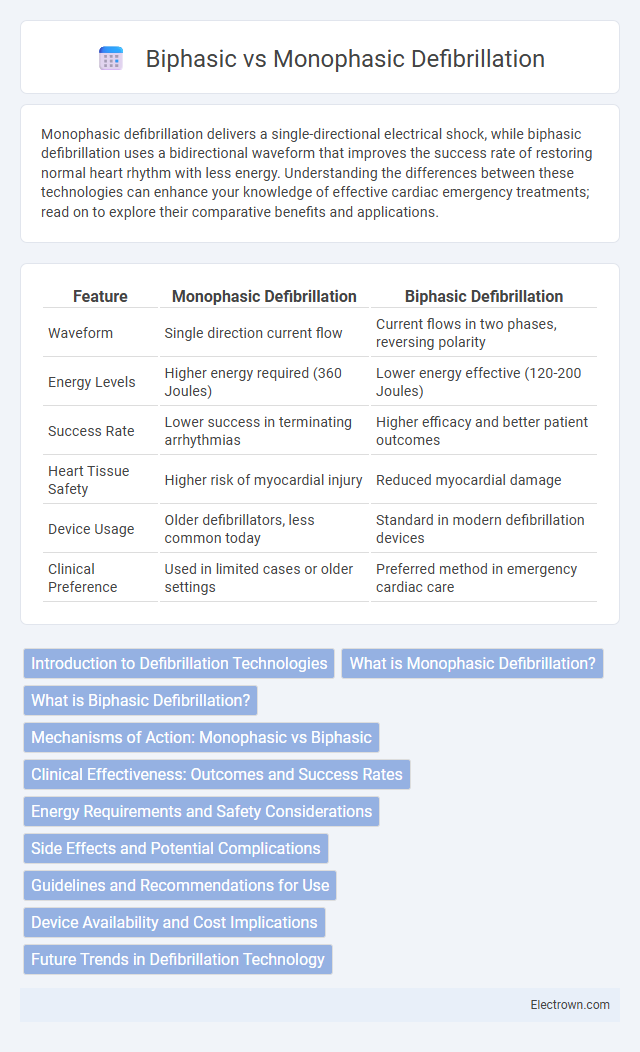Monophasic defibrillation delivers a single-directional electrical shock, while biphasic defibrillation uses a bidirectional waveform that improves the success rate of restoring normal heart rhythm with less energy. Understanding the differences between these technologies can enhance your knowledge of effective cardiac emergency treatments; read on to explore their comparative benefits and applications.
Table of Comparison
| Feature | Monophasic Defibrillation | Biphasic Defibrillation |
|---|---|---|
| Waveform | Single direction current flow | Current flows in two phases, reversing polarity |
| Energy Levels | Higher energy required (360 Joules) | Lower energy effective (120-200 Joules) |
| Success Rate | Lower success in terminating arrhythmias | Higher efficacy and better patient outcomes |
| Heart Tissue Safety | Higher risk of myocardial injury | Reduced myocardial damage |
| Device Usage | Older defibrillators, less common today | Standard in modern defibrillation devices |
| Clinical Preference | Used in limited cases or older settings | Preferred method in emergency cardiac care |
Introduction to Defibrillation Technologies
Defibrillation technologies are critical in restoring normal heart rhythm during cardiac arrest by delivering controlled electrical shocks to the myocardium. Monophasic defibrillators release a single-direction electrical pulse, while biphasic defibrillators deliver current in two phases, enhancing efficacy and reducing the required energy levels. Advances in biphasic waveform design improve patient outcomes by minimizing myocardial damage and increasing the likelihood of successful defibrillation.
What is Monophasic Defibrillation?
Monophasic defibrillation delivers an electric shock in a single direction through the heart, typically using a higher energy level ranging from 360 to 400 joules. This method is effective in terminating ventricular fibrillation but often requires more energy and can cause greater myocardial damage compared to biphasic waveforms. Monophasic defibrillators are less commonly used today as biphasic technology provides improved efficacy and safety at lower energy levels.
What is Biphasic Defibrillation?
Biphasic defibrillation delivers an electric shock that reverses direction partway through the pulse, enhancing the efficiency of restoring normal heart rhythm compared to monophasic defibrillation. This method uses lower energy levels, reducing the risk of myocardial injury and increasing the success rate of terminating ventricular fibrillation or pulseless ventricular tachycardia. Clinical studies demonstrate biphasic waveforms optimize defibrillation thresholds, making them the preferred choice in modern automated external defibrillators (AEDs) and clinical defibrillators.
Mechanisms of Action: Monophasic vs Biphasic
Monophasic defibrillation delivers a single, unidirectional current wave to depolarize the myocardium, requiring higher energy levels to successfully terminate arrhythmias. Biphasic defibrillation uses a current that reverses direction partway through the shock, enhancing myocardial cell membrane depolarization more effectively at lower energy settings. This bidirectional mechanism reduces myocardial injury and improves defibrillation success rates compared to monophasic waveforms.
Clinical Effectiveness: Outcomes and Success Rates
Monophasic defibrillation delivers a single-direction current and has historically shown lower success rates in terminating ventricular fibrillation compared to biphasic defibrillation, which uses current that reverses direction, improving myocardial capture and reducing energy requirements. Clinical studies report biphasic defibrillators achieving first-shock success rates exceeding 90%, while monophasic devices generally demonstrate success rates around 70-80%. To optimize your clinical outcomes, selecting biphasic defibrillation is strongly supported by higher efficacy and improved patient survival rates in cardiac arrest scenarios.
Energy Requirements and Safety Considerations
Monophasic defibrillators typically require higher energy levels, often between 360 to 400 joules, to achieve effective cardiac defibrillation, whereas biphasic devices use lower energy, usually ranging from 120 to 200 joules, reducing myocardial damage and increasing safety. Biphasic waveforms deliver current in two phases, improving energy efficiency and minimizing skin burns and post-shock complications compared to monophasic shocks that use a single, high-energy pulse. Your choice between monophasic and biphasic defibrillation impacts both the energy settings needed for successful resuscitation and the potential for adverse effects during treatment.
Side Effects and Potential Complications
Monophasic defibrillation often requires higher energy levels, which can increase the risk of skin burns and myocardial injury. Biphasic defibrillation delivers energy more efficiently, reducing the likelihood of cardiac tissue damage and post-shock arrhythmias. Your choice between the two should consider the balance between effectiveness and minimizing side effects like myocardial stunning or electrode burns.
Guidelines and Recommendations for Use
Guidelines recommend biphasic defibrillation due to its higher efficacy and lower energy requirements compared to monophasic defibrillation, improving patient outcomes during cardiac arrest. The American Heart Association emphasizes using biphasic waveforms as the standard in advanced cardiac life support protocols for sudden cardiac arrest. Monophasic defibrillators are considered less effective and are largely phased out in favor of biphasic devices to align with updated resuscitation practices.
Device Availability and Cost Implications
Monophasic defibrillators are generally more affordable and widely available, making them a common choice in lower-resource settings. Biphasic defibrillators, while typically more expensive due to advanced technology and improved efficacy, offer better patient outcomes with lower energy requirements and less myocardial damage. Your selection between these devices should consider both cost constraints and the availability of advanced technology for optimal defibrillation effectiveness.
Future Trends in Defibrillation Technology
Future trends in defibrillation technology emphasize the development of adaptive, biphasic waveforms tailored to individual patient impedance, enhancing shock efficacy and minimizing myocardial damage. Integration of artificial intelligence algorithms into defibrillators aims to optimize energy delivery and improve real-time rhythm analysis for more accurate arrhythmia detection. Advances in wearable and implantable defibrillator devices focus on continuous monitoring capabilities, promoting early intervention and reducing sudden cardiac arrest mortality rates.
Monophasic vs Biphasic Defibrillation Infographic

 electrown.com
electrown.com